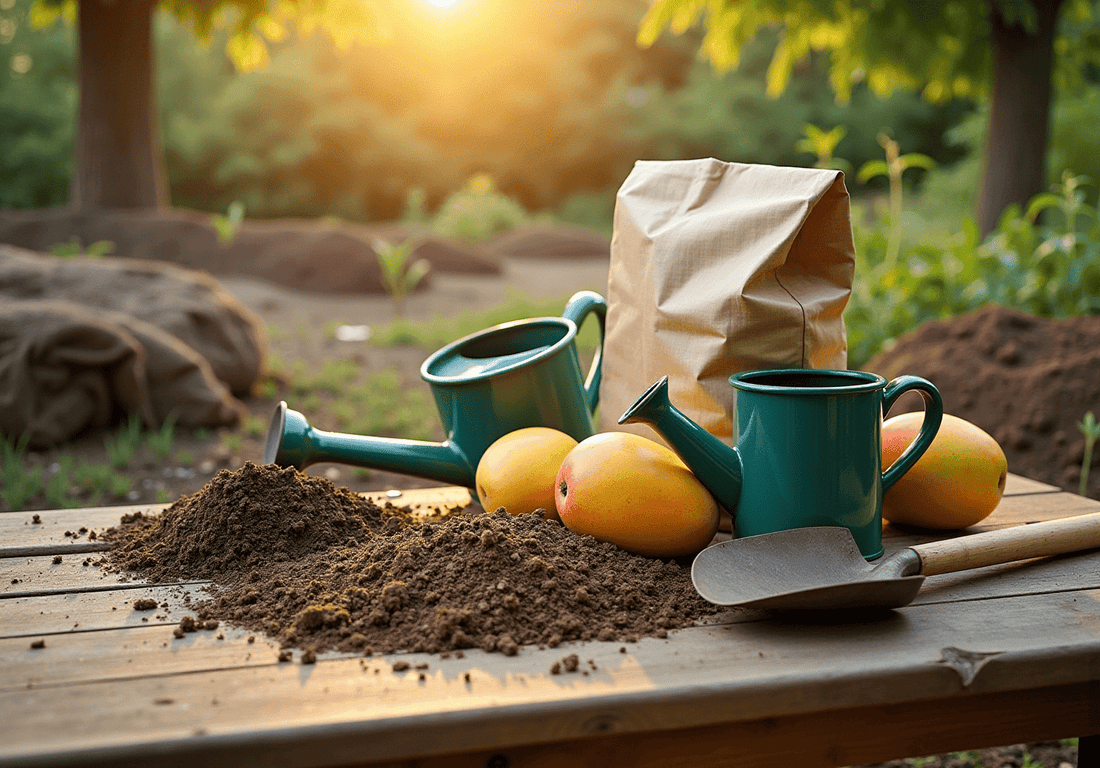
How to Grow a Healthy Duncan Mango Tree
Share
Growing a healthy Duncan mango tree can be a rewarding experience, and it all begins with understanding the essential steps involved. First, gather the right tools—this is your foundation. Then, selecting an optimal planting site is crucial; consider where your tree will thrive best.
When it comes to planting, doing it properly sets the stage for success. Remember, nurturing your tree doesn’t end there; maintaining its care is vital. Regular watering, thoughtful fertilizing, and diligent pest management are key aspects of keeping your tree healthy.
However, challenges may arise. This is where troubleshooting common issues becomes important. By addressing these concerns early, you can ensure your tree grows strong and produces delicious fruit.
Each step of the process comes with practical advice on soil preparation and care, emphasizing the importance of the right environment for your tree's growth. So, as you embark on this gardening journey, know that with proper care and attention, your Duncan mango tree can flourish beautifully. Let's nurture it together!
🌱 Ready to grow your own?
Shop the Cogshall Mango Tree here or browse our full Mango Tree Collection to find the best fit for your garden.
Cultivating a Duncan mango tree is a truly rewarding venture that not only enhances your garden but also offers the sweet joy of homegrown fruit. Have you ever dreamed of enjoying fresh mangoes right from your backyard? From selecting the right tools to nurturing your tree through its growth stages, each step is vital for ensuring its success.
In this guide, we’ll explore the essential practices of planting and caring for a Duncan mango tree, focusing on:
- Site selection
- Soil preparation
- Ongoing maintenance
Whether you’re a novice gardener or an experienced horticulturist, understanding the nuances of mango cultivation can lead to bountiful harvests and a thriving garden ecosystem. Let’s embark on this journey together, nurturing both your tree and your gardening skills.
Gather Essential Tools and Materials
To successfully plant a duncan mango tree, let’s gather the essential tools and materials together. First, we need:
- A shovel for digging the hole, allowing ample space for root development.
- A garden rake to even the ground and clear away debris, creating a tidy area for sowing.
- A watering can or hose for irrigating the plant right after planting, ensuring it receives the moisture it needs to establish itself.
- Organic mulch, such as wood chips or straw, to assist in retaining moisture and regulating temperature.
- A balanced fertilizer suitable for fruit trees to promote healthy growth and fruit production.
In addition, incorporating ground enhancements like compost or well-rotted manure enriches the earth, providing vital nutrients for your tree. Remember to wear gloves to protect your hands while working with soil and plants, ensuring comfort and safety. A trowel is also perfect for minor excavation tasks and accurate sowing, especially in confined areas.
Before we commence, let’s ensure all tools are clean and in proper condition to enable a seamless sowing process. Investing in quality tools not only improves our cultivation experience but also aids in the long-term success of your fruit plant. Did you know that utilizing the right gardening tools can greatly enhance cultivation results? For instance, the tensile strength of the suggested hemp cord for garden twine is rated up to 170 pounds, highlighting the significance of tool quality. As gardening expert Linda Ly beautifully states, 'The right tools can make all the difference in ensuring your plants thrive.'
Additionally, Everglades Farm's commitment to quality shines through in their customer satisfaction, with 79% of reviews rating their service as five stars. Understanding the average cost of gardening tools can help us make informed decisions, ensuring we invest wisely in our gardening endeavors. Each tool plays an essential role in the successful development of your duncan mango tree, so let’s select carefully and nurture our gardens together.
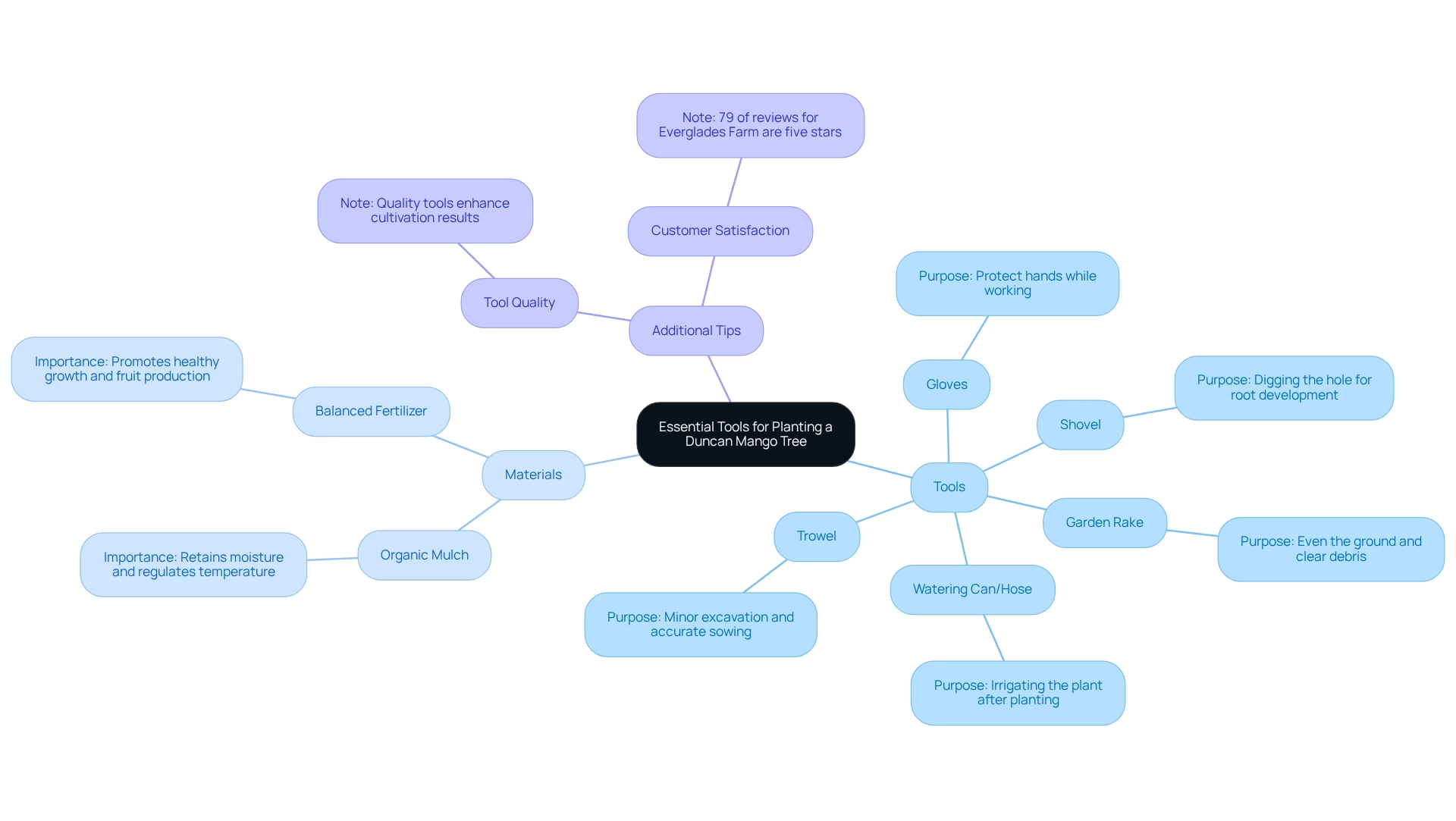
Select an Optimal Planting Site and Prepare the Soil
To successfully grow a healthy duncan mango tree, let’s explore some essential steps for selecting the ideal planting site and preparing the soil.
- Select a sunny spot: Mango plants truly thrive in bright conditions, requiring at least 6-8 hours of direct sunlight each day. A well-lit area will not only promote optimal growth but also enhance fruit production, making your gardening efforts worthwhile.
- Check drainage: It’s crucial to choose a location with well-draining soil to avoid waterlogging, which can lead to root rot. We recommend steering clear of low-lying areas where water tends to accumulate, as these can hinder your plant’s health and vitality. The duncan mango tree flourishes in slightly acidic to neutral conditions, ideally within a pH range of 5.5 to 7.5. Using a testing kit to determine the pH level is a simple yet effective way to ensure it falls within this optimal range for healthy growth.
- Prepare the ground: Start by clearing the area of weeds and debris, creating a clean slate for your mango tree. Excavate a pit that is 2-3 times broader than the root ball of the plant and of comparable depth. Enhance the soil by incorporating compost or well-decomposed manure, which will supply vital nutrients for your tree. As Tara Slaven from the Australian National Mango Breeding Program points out, nutritional management is especially crucial in denser soils, as it significantly influences fruit quality.
- Loosen the earth: Use a garden rake to break up any compacted soil, promoting good aeration for the roots. Proper aeration is essential for root development and overall plant health, ensuring your mango tree has the best chance to thrive.
By carefully preparing the ground and selecting the right location, you create a strong foundation for your fruit plant, enhancing its growth potential and fruit quality. Remember, these fruits can thrive in various soil types, from light sands to dense clays, but they excel in well-drained, slightly acidic substrates that are 1 to 2 meters deep. With this knowledge, you’re well-equipped to make informed planting choices that will lead to a bountiful harvest.
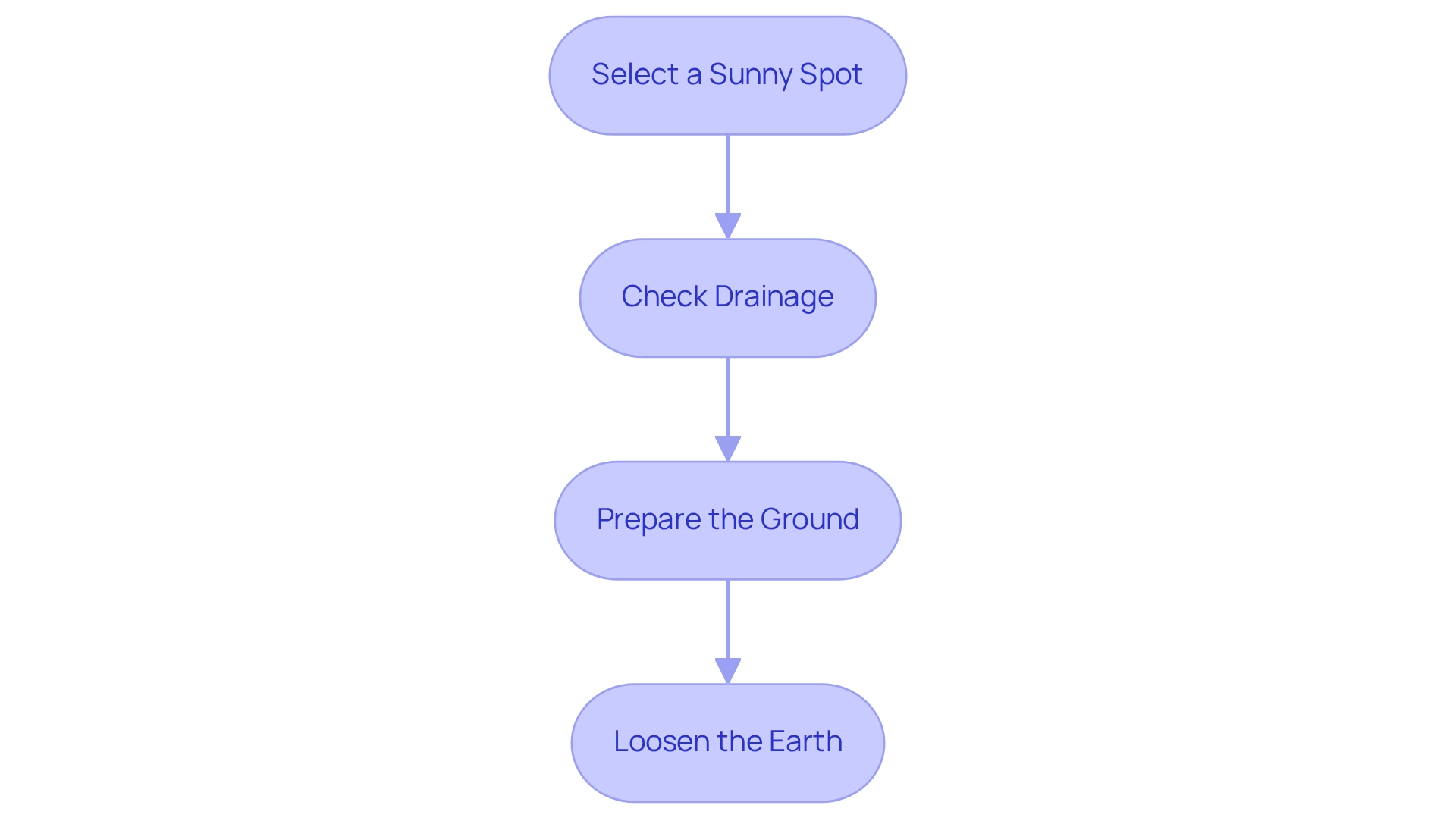
Plant the Duncan Mango Tree
To successfully plant your Duncan mango plant, let’s walk through these caring steps together:
- Gently remove the plant from its container: Tap the sides of the pot softly to loosen the earth, then carefully slide the plant out, being mindful to minimize any damage to the roots. Position the tree thoughtfully: Center the tree in the prepared hole, ensuring the top of the root ball is level with or slightly above the surrounding ground. This helps prevent water from pooling around the trunk, which can be detrimental.
- Backfill the hole with care: Fill the hole with your prepared earth mixture, gently packing it down to eliminate air pockets. Creating a small mound of earth around the base will enhance water retention, nurturing your plant.
- Irrigate thoroughly: After placing your plant, give it a deep watering to firm the earth around the roots, ensuring that moisture reaches the root zone effectively. This is crucial for establishing a strong foundation.
- Apply mulch with intention: Add a 2-3 inch layer of organic mulch around the base of the plant, keeping it a few inches away from the trunk to avoid rot. This will help etain moisture and protect your plant.
For those also interested in planting soursop plants, similar best practices apply. Choose a sunny spot with well-draining soil, and ensure sufficient spacing between plants to encourage airflow and minimize pest problems. Regularly monitor for pests and diseases, and consider organic treatments to maintain plant health. Remember, following these nurturing steps will assist your Duncan plant in establishing itself in its new surroundings, and soon you’ll be able to enjoy the fruits of your labor.
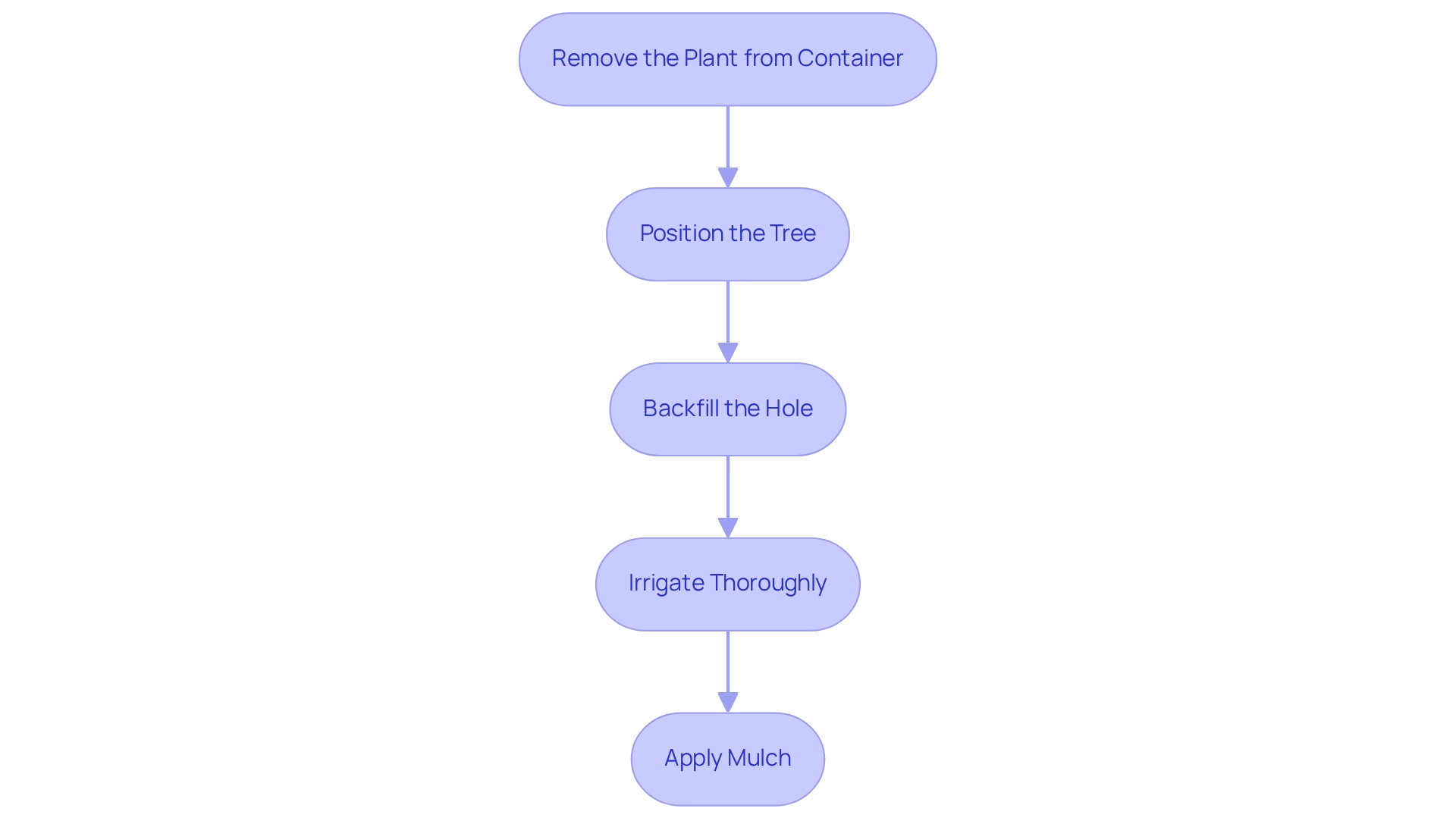
Maintain and Care for Your Mango Tree
To help your Duncan mango tree flourish, let's explore some nurturing care practices together:
- Watering: It's important to hydrate your plant thoroughly but infrequently, allowing the top inch of soil to dry out between waterings. In the first year, aim for weekly watering, and increase this during dry spells to maintain optimal moisture levels. Embracing sustainable methods, like efficient irrigation management, can help conserve water while ensuring your plant receives the hydration it needs.
- Fertilizing: Consider applying a balanced fertilizer every 6-8 weeks during the growing season—spring and summer. Following the manufacturer's instructions for application rates can promote healthy growth and vitality.
- Pruning: Annual pruning is a wonderful opportunity to remove dead or diseased branches and shape the canopy. This practice not only enhances air circulation but also allows sunlight to penetrate, both of which are crucial for fruitful development.
- Pest Management: Regularly inspecting your plant for pests like aphids or mealybugs is key. If you spot any, using organic insecticidal soap can be effective; just be sure to follow the product instructions to protect beneficial insects.
- Mulching: Maintaining a layer of mulch is a simple yet effective way to retain soil moisture and suppress weeds. Remember to replenish the mulch as needed, especially after heavy rains, to ensure consistent moisture retention.
By embracing these maintenance suggestions, you can encourage healthy growth and optimize the fruit yield from your beloved plant. Studies show that with optimal care, you can achieve an average yield of 40 fruits per monitoring period. As Oscar de la Renta wisely said, "Gardening is the work of a lifetime: you never finish." So, let’s embrace this journey together with your duncan mango tree, and savor the rewards of your dedicated efforts.
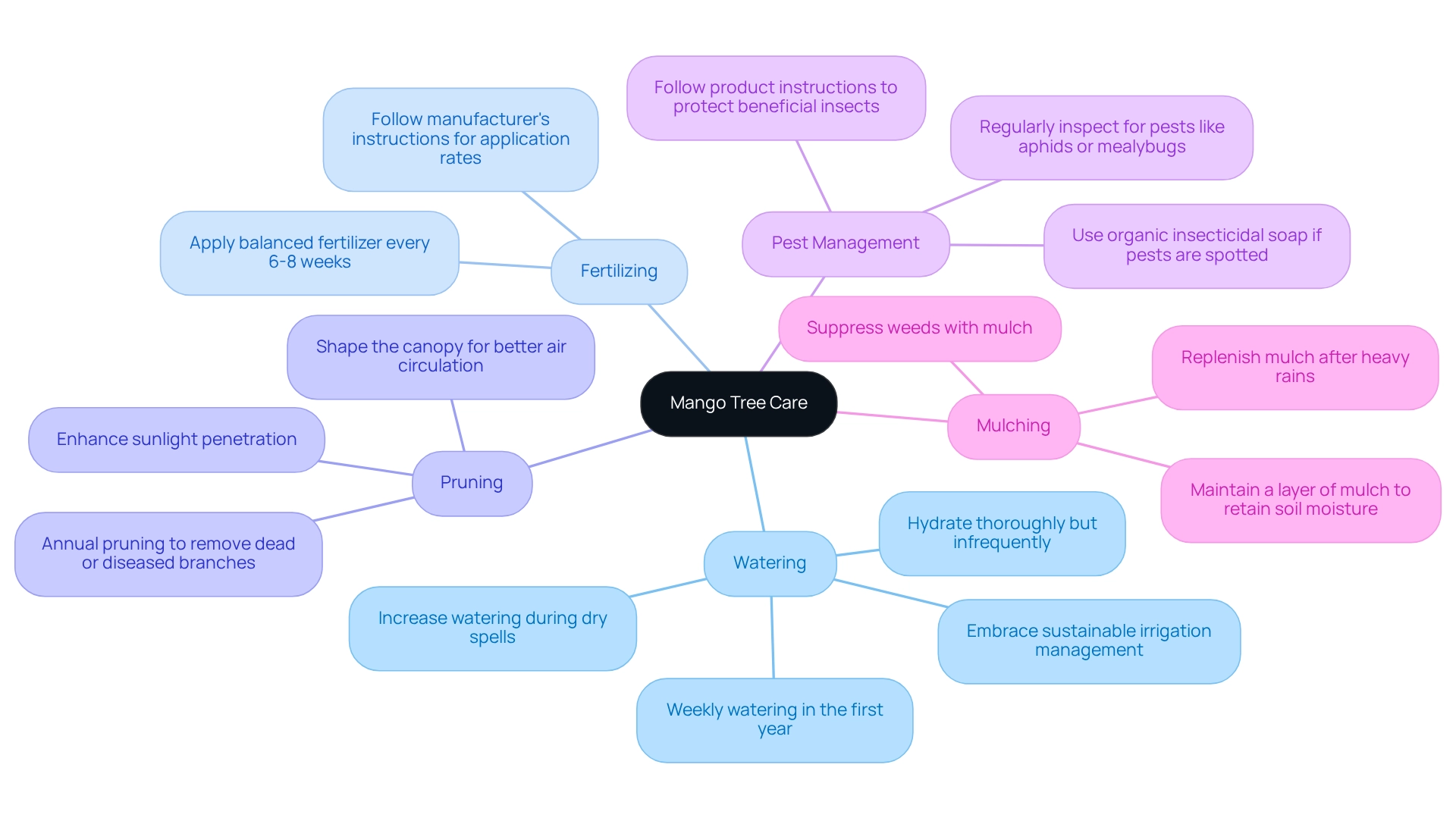
Troubleshoot Common Issues in Mango Cultivation
If you encounter issues while growing your duncan mango tree, consider these helpful troubleshooting tips:
- Yellowing Leaves: This may indicate overwatering or a nutrient deficiency. Check the ground moisture and adjust your watering schedule accordingly. If you suspect a nutrient deficiency, applying a balanced fertilizer can help restore your plant's health.
- Poor Fruit Set: Insufficient pollination or stress from environmental factors can lead to low fruit production. Ensure your plant is in a sunny spot, and consider adding companion flora to attract pollinators. Remember, as Joel Salatin observed, the aim of sustainable agriculture should be to restore the ground and the ecosystem, not merely to keep them.
- Leaf Spots or Wilting: These symptoms may suggest fungal infections or pests. Inspect the leaves for signs of pests and treat with organic pesticides if necessary. Ensure good air circulation around your duncan mango tree to prevent these issues.
- Stunted Growth: This can result from poor land conditions or inadequate watering. Testing the soil pH and making necessary amendments can improve growth. Consistent watering practices are essential for optimal development.
- Fruit Drop: Young fruit-bearing plants may shed produce as they establish themselves. However, excessive dropping can indicate stress. Monitor your watering and fertilization practices to ensure your plant remains healthy. Interestingly, wooden or cardboard containers used for packing the duncan mango tree's fruit can accommodate 5 to 8 kg of produce, highlighting the significance of proper handling and care during the fruiting stage.
By being proactive and attentive to the duncan mango tree's needs, you can effectively manage and resolve common cultivation issues, ensuring a fruitful harvest. Additionally, consider engaging with community events like the Summer Mango Mania Promotion, which showcases successful mango cultivation practices and offers valuable insights for home gardeners. Together, we can nurture our gardens and enjoy the fruits of our labor.

Conclusion
Successfully cultivating a Duncan mango tree is a journey filled with care and dedication, from planting to ongoing maintenance. It all begins with essential tools and materials that lay the groundwork for a smooth planting process and long-term success. By selecting an optimal site with ample sunlight and proper drainage, you set the stage for healthy growth. Thorough soil preparation enriches the environment, creating a nurturing space for your tree to thrive.
As you embark on this journey, remember that planting techniques are crucial. Positioning your tree carefully and providing thorough watering will help settle its roots. Once planted, consistent maintenance practices—like appropriate watering, fertilization, and pest management—become vital for promoting robust growth and maximizing fruit production. Being aware of common issues, such as yellowing leaves or poor fruit set, empowers you to troubleshoot effectively and maintain a healthy tree.
Ultimately, nurturing a Duncan mango tree is about more than just the immediate rewards of fruit; it’s about the joy of gardening itself. Embracing this process fosters a deeper connection with nature and offers the sweet satisfaction of enjoying homegrown mangoes. With patience and perseverance, your journey of cultivating a Duncan mango tree can lead to a bountiful harvest and a thriving garden ecosystem. So, let’s embrace this beautiful adventure together, and enjoy every moment of growth!
🌴 Ready to Plant Your Own Duncan Mango Tree?
With the right care and a little patience, the Duncan Mango Tree can reward you with years of juicy, delicious fruit—right from your backyard.
👉 Buy your grafted Duncan Mango Tree now
👉 Explore the full Mango Tree Collection
👉 Discover more fruit trees perfect for Florida gardens
Frequently Asked Questions
What tools are needed to plant a duncan mango tree?
The essential tools include a shovel for digging, a garden rake for leveling the ground, a watering can or hose for irrigation, organic mulch to retain moisture, and a balanced fertilizer suitable for fruit trees. A trowel is also useful for minor excavation tasks.
Why is it important to use quality tools for planting?
Investing in quality tools enhances the cultivation experience and contributes to the long-term success of the fruit plant. Clean and properly maintained tools ensure a seamless sowing process.
What should be considered when selecting a planting site for a duncan mango tree?
The site should receive at least 6-8 hours of direct sunlight daily, have well-draining soil to prevent waterlogging, and ideally fall within a pH range of 5.5 to 7.5. Avoid low-lying areas where water accumulates.
How should the soil be prepared before planting a duncan mango tree?
Clear the area of weeds and debris, excavate a pit 2-3 times broader than the root ball, and incorporate compost or well-decomposed manure to enrich the soil. Loosen compacted soil with a garden rake to promote aeration.
What type of soil conditions are ideal for a duncan mango tree?
Duncan mango trees thrive in well-drained, slightly acidic substrates that are 1 to 2 meters deep. They can grow in various soil types, including light sands and dense clays, but prefer slightly acidic to neutral conditions.


